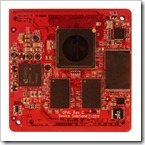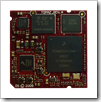GuruCE have been hard at work on the Windows CE BSP for Topaz recently, and have a new release with several bug fixes and improvements. The release includes updated Topaz image binaries, binary BSP and SDK.
Posts Categorized: Topaz
Posted by & filed under Topaz, Windows CE.
Topaz Windows CE update from GuruCE
GuruCE have released an update to the Topaz BSP for Windows CE 6.0. The best new feature is support for a splash screen on boot. This is very simple to use – just pick an image and download using the updated Topaz Flasher.
The release also includes updates to the FlexCAN driver and serveral other features and fixes.
You can download the binary BSP and pre-built Topaz i.MX25 Development Kit image here.
Posted by & filed under Linux, Topaz, Windows CE.
Announcing the Topaz SO-DIMM module

Meet the latest addition to the device solutions module family: the Topaz i.MX25 CPU module in a plug-in, 200-pin SO-DIMM form factor.
This is the same circuit as the surface-mount version, so transitioning a design from one to the other is easy.
It also has the same world-class operating system support for Windows Embedded CE from GuruCE and Linux from Trygtech.
The new form-factor offers excellent flexibility for prototyping new designs, and makes production easier – especially for low-volume products. The surface-mount module is still available and ideal for applications that need a low profile module, or operate in high-vibration environments.
The Topaz web page has all the details including an updated Technical Reference Manual and schematic library symbols.
Contact us for samples – they are in stock now!
Posted by & filed under Linux, Opal, Topaz, Windows CE.
FAQ: Designing with Device Solutions Processor Modules



Designing with a processor module is about more than making sure the technical specs meet your needs. Hardware and software design support are essential to making projects successful.
We have put together some of the frequently asked questions to give you an idea of how the design process works with our modules. It includes hardware design and the support we provide, operating system support and how that is delivered in conjunction with our software partners, and manufacturing questions.
We are pretty sure this document is not going to answer all your questions, but even if it does, we would love to talk to you about your project.
Posted by & filed under Linux, Opal, Topaz, Windows CE.
Partners

“Focus on what you are good at” is a message we give our customers all the time. When designing embedded products, starting with a processor module lets you do just that. We try to do the same in our business, and partner with other companies so that we can focus on designing and manufacturing the best modules.
We recently added a Partners page to our web site that highlights the companies we are working with. Some have been visible on our web site before, like GuruCE and Trygtech who provide Operating System ports.
A new section is our System Integrators. These are companies who have experience in designing with our modules and provide turn-key product development. If you are looking for help with your new project, get in touch directly or contact us for an introduction.
Posted by & filed under .NET Micro Framework, Topaz.
.NET Micro Framework on Topaz

We have an ALPHA version of the .NET Micro Framework port for the Topaz i.MX25 Development Kit available for download. Features included in this release are:
– LCD
– Touch
– Serial ports
– GPIO
– SPI
– File System and Extended Weak References
– ADC and PWM
The help file and release notes have more information. There is no SDK installer, however there are libraries included for accessing GPIO, ADC, PWM and the LCD configuration routines.
This is an alpha release, which means you will most likely find bugs! Please report any issues to support<at>devicesolutions.net. We also want to hear from you as to which features you need. Ethernet will be the next major feature added.
Posted by & filed under .NET Micro Framework, Topaz.
UPDATE: .NET Micro Framework on Topaz
While the blog may have been quiet, we have been working away on getting the .NET Micro Framework running on the Topaz CPU module and Development kit. We have managed applications running with output on the LCD. Download and debug is via serial for now.
Before we get this out to anyone there is some more testing to be done and a couple more drivers to add to make it useful. This is our priority after returning from a short Christmas/Summer break!
If you would like to be added to the list to receive the alpha release, please contact us here.
Posted by & filed under Topaz.
Picking and choosing: Getting the mix of features right when designing with the Topaz i.MX25 CPU Module

The Freescale i.MX25 is at the heart of the Topaz CPU Module. This chip multiplexes it’s many features to a much smaller number of pins, which can give you a headache when trying to get the right combination for a design.
While all the information you need is in the data sheet, Freescale have a tool which makes this task a lot easier! The IOMux tool can be downloaded from the i.MX25 tools page on the Freescale web site. Go here and search for “pin mux tool”.
Once you have this downloaded and running, download and open the Topaz file from here. This defines all the pins used on the Topaz CPU module, so you know that any free signals are available for you to use. The IOMux tool looks like this:

To use the tool, just select the features you need in your design. The tool will show pins in use as yellow, and conflicts as orange. With a bit of trial and error you should be able to come up with a combination that works for your product.

We have found this a useful tool when communicating with customers about their exact requirements and it is an easy way to document your design.
Posted by & filed under Topaz, Windows CE.
Windows Embedded Compact 7 on Topaz
GuruCE has released a new BSP which includes support for Windows Embedded Compact 7 on Topaz.
The release also includes an update to the Windows CE 6.0 R3 BSP and the Topaz Flasher application.
You can download a binary image and a binary BSP for free, with the source code available when you purchase support.
GuruCE has done a lot of work on the BSP and it now includes enhanced support for many of the devices on the i.MX25, including a comprehensive GPIO driver. For a small fee there are also a suite of managed wrappers making it very easy to access hardware from your Compact Framework application.

